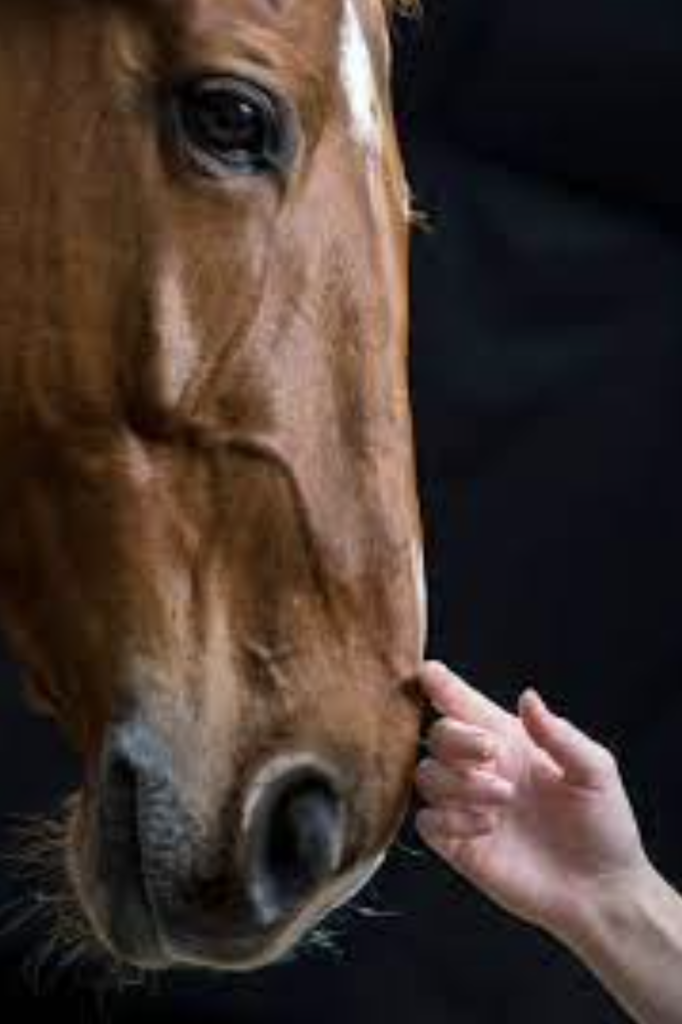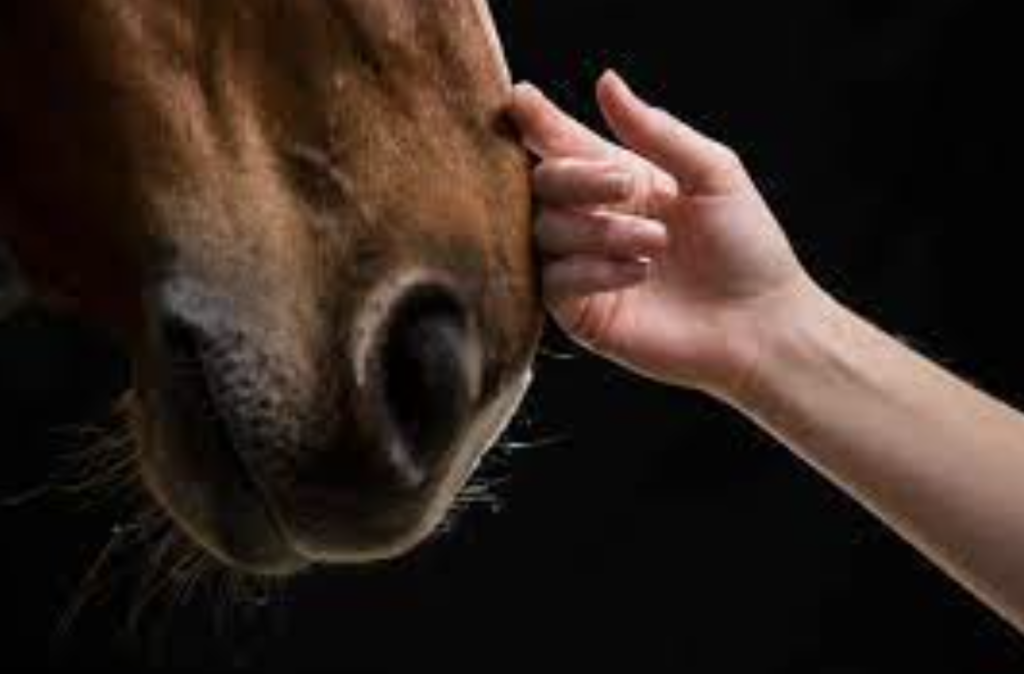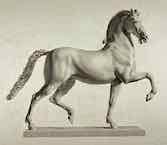© Regina Koehler, equinology equine body worker, clinical psychologist, 2023

The following case study explores how equine massage and, more broadly, different types of body work, can have a positive impact on equine mental health. This case study focuses on a 13 year old French saddle bred gelding, which I call Atlas hereafter (names have been changed to protect the privacy of his owners) who suffered from a mood disorder prior to treatment.
Atlas lives and works in a French riding school, in similar condition as the other riding school horses. People working with him have commented on the dramatic changes in his personality and well-being after the first sessions of body work. From the passive, non-responsive, lethargic and sad looking equine he was, to the playful, communicative and very social gelding, who jumps around like a young goat trying to get the Shetland ponies he is sometimes in the arena with, to play with him, among others. As the typically depressed horse, he was completely shut down and would not even lie down to roll when let free in the arena, when I first met him.
In order to hypothesize about the positive effect of body work on equine mental health and in particular depression, I drew on human polyvagal theory. Sarah Schlote has applied polyvagal theory to equines, her work can be found on her website Equusoma.
Further, in his masterpiece “The Body keeps the Score”, Dr. Bessel van der Kolk writes about the polyvagal theory (p.78), as it applies to humans: “the polyvagal theory provides us with a more sophisticated understanding of the biology of safety and danger (…). It explains why a kind face or a soothing tone of voice can dramatically alter the way we feel. It clarified why knowing that we are seen and heard by the important people in our lives can make us feel safe and calm and why being ignored and being dismissed can precipitate rage reactions or mental collapse. It helped us understand why focused attunement with another person can shift us out of disorganized and fearful states. In short, Porges’ theories make us look beyond the effects of fight or flight and put social relationships front and center in our understanding of trauma. It also suggested new approaches to healing that focus on strengthening the body’s system for regulating arousal.(…) safety and support is the most powerful protection against becoming overwhelmed by stress and trauma”.
Why would those ideas hold for equines too? Because the nervous systems of humans and horses have evolved in similar ways, in similar environment, for thousands of years, and show many parallels. Horses are highly social animals, and equine body work and massage requires consent, there is no relaxing effect in a non-consenting horse. Equine massage is a interspecies dialogue that cannot be thought of without attunement.
What would be the precise mediators of the positive changes in wellbeing seen in particular in Atlas? One must not forget that the horses are housed in single boxes, have little opportunity to interact with other equines and most of their lives consist of being asked to function for the job they are there for. In the world of humans, much of their nonverbal communication is not recognized and not taken into account most of the time, as humans are not able to make sense of them or even to be aware of them as communication. Think of the wrinkles over the eyes or the slight movement away of the head and neck, tension in the nostrils or mouth area etc.
Body work on the other hand, if done with intent, in a meaningful way for the equine, in a way in which the equine feels s/he as agency and feels s/he is seen and heard with her/his preferences, likes and dislikes, can have powerful effects in the sense described by van der Kolk. In such a context, body work can be a radical experience, a resource for regulation, connection and safety for the horse, instead of stress and disconnection, and agency instead of the ‘oppression’ that much of their experience of the riding school environment might be made of. (I’m speaking here more from a general point of view : the average riding school in this country overall, as opposed to what their lives would be in more natural environment and living conditions of horses. The riding school where Atlas works and lives actually has some positives practices in place that I have not seen elsewhere, my feeling is their lives are somewhat better here, eg. they have some limited social tactile contact, as they have only a chain instead of door with anti-weave bars which allows for zero social tactile contact).
In “The Pocket Guide to sensorimotor psychotherapy in context” Dr. Pat Ogden writes “In the treatment of trauma, Sensorimotor Psychotherapy prioritizes bottom-up interventions (from the body vs the brain) by directly targeting the body’s movement and sensation (…). Because trauma first and foremost affects the body and nervous system, and trauma-related vehement emotions are not resolved by their (verbal) expression, bottom-up interventions are paramount. Addressing the effects of trauma emphasizes working with sensation, movement, and the slow progressive process of stimulating dysregulation and reregulating it with somatic resources and physical action, thus building regulatory capacity.” In Ogden’s view, body centered or bottom up approaches to mental distress have the power to make the individual more resilient by building regulatory resources.
While at a very exploratory stage for me (Sarah Schlote says more about it on her website however, as does Dr. Gala Argent in her wonderful paper on human horse attunement titled “Can You Hear Me (Yet)?- Rhetorical Horses, Trans-species Communication, and Interpersonal Attunement” (2022), I believe the effect of the body work sessions on the mind of the equines can be described to some extend with those theories.
On the other hand, the aversive effects of stress on the body’s fascia are well researched. The relaxing and healing effect of massage cannot be reached without the consent of the equine in every moment of the process. Therefore, an equine body work session is as much about parts of anatomy being manually worked and physical flexibility etc. restored, as it is about communication and dialogue between two individuals.

Mindful presence on the side of the therapist is a prerequisite, as is the capacity to see equine nonverbal communication as communication in its own right, “sufficient” and understandable by humans as well as openness and readiness to “listen” to it, in a way that Nahshon Cook brilliantly describes in its extraordinary book “Being with horses”.
As a therapist and equine body worker, I feel that within this single housing context and within these circumstances, the body work sessions probably offered “healing attunement” to this depressed albeit very social horse. How many sessions are necessary to reach a change? He changed during the first session already : at one point I kneeled down to get something out of my bag and I felt him put his chin on my shoulder, in that moment I knew body work would help him. But obviously, there must be some change to his life situation to see a durable change. This must not be spectacular, sometimes small changes can have a huge impact.
Ressources
Reconnaître et traiter la dépression chez l’équidé
Dr. Bessel van der Kolk ”The Body Keeps the Score” 2013
Dr. Gala Argent, “Can you hear me (yet) ?” 2022
Nahshon Cook ”Being with Horses” 2022
Dr. Pat Ogden ”The Pocket Guide to sensorimotor psychotherapy in context”
